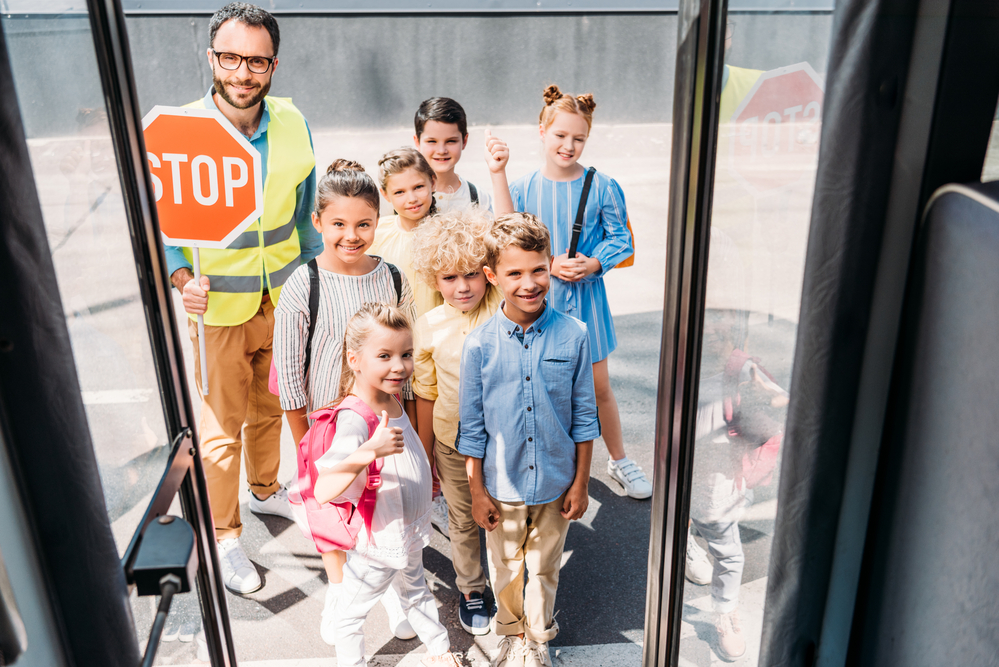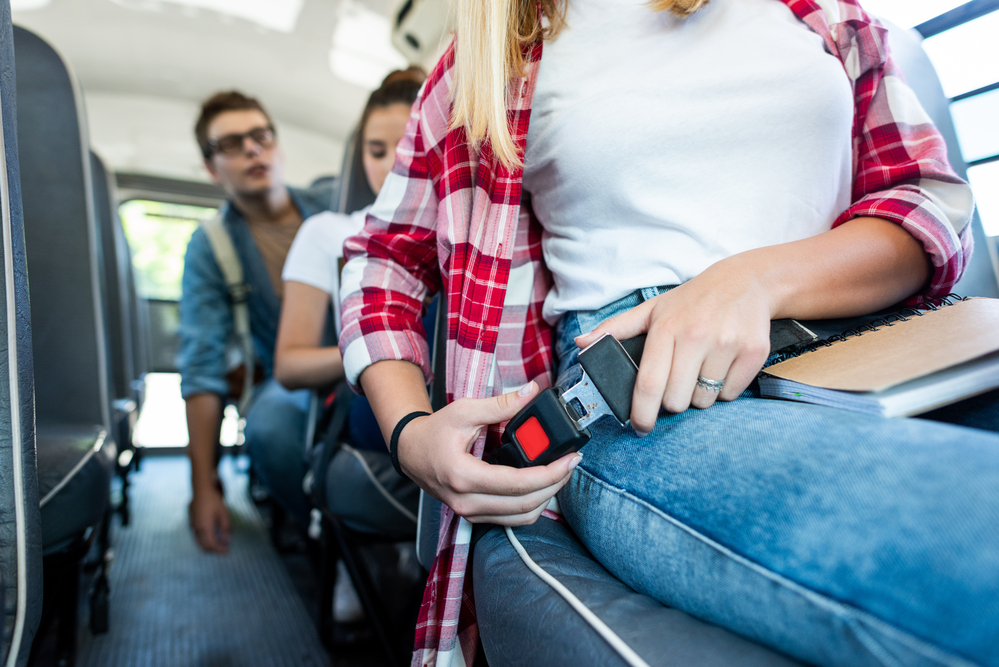
Recently, I had occasion to patronize a school bus. (No, I didn’t enroll in kindergarten. if you must know, I do competitive race walking, and the buses were needed to get us from the parking lot to the starting point of the race, and back). I’m not really overweight (I keep telling myself), but the seats were a really tight fit for ordinary people. No mystery here: these vehicles are used primarily to ferry around school children, and they are lots easier to squeeze into limited spaces than adults.
But the shockeroo was that there were no seat belts available anywhere; not a single one. I would have thought that if seat belts actually save lives, young children would have them most certainly, and first to boot, since they are smaller, weaker, and more vulnerable than grown-ups.
Shows how much I know.
So I did a bit of research, to try to find out how the all and ever-loving state apparatus could have missed this seemingly splendid paternalistic opportunity. What I came up with was not comforting at all.
One theory is that of “compartmentalization.” According to the National Highway Traffic Safety Administration (NHTSA – the group that is responsible for some 40,000 annual highway deaths) “…(t)his requires that the interior of large buses protect children without them needing to buckle up. Through compartmentalization, children are protected from crashes by strong, closely-spaced seats that have energy-absorbing seat backs.”

I don’t know about those “energy-absorbing seat backs.” During my brief trip, I touched the one in front of me. It might have “absorbed energy,” whatever that means, but it seemed pretty solid to me. I’d sure hate to collide with one if them in an accident. I’m not too confident that a seven-year-old child would do very well at all in impacting them. And, if they were so great, why not require that all transportation vehicles employ them? It simply makes no sense to bifurcate matters in this manner; we are all frail human beings – children and adults alike — when one vehicle rams into another at speed.
Here is another justification: “School buses are most often used to transport children, and the only adult in the vehicle is there to drive. In the instance where there was an accident, the driver would likely have to unbuckle the passengers, a time-consuming process that could prove dangerous for others.” But this is just plain silly. Ten-year-olds, and even younger children, are perfectly capable of unbuckling their seat belts, and buckling them too. They do so every day in their family automobiles. This hardly explains why so called “public transportation”, street buses, subway trains, Amtrak, etc., are also lacking seat belts.
Here is yet another justification: “A seatbelt is of most use where a collision causes rapid deceleration. Trains carry so much momentum that they do not stop rapidly, even in very severe collisions.” This a good competitor with the previous excuses in the silliness sweepstakes. You can’t tell me that when two trains, or buses, meet in a head-on collision, that they don’t both stop rapidly, and on the dime, despite massive previous momentum. Ditto for when a bus impacts a really thick brick wall, no matter has fast it was going beforehand.
Here is an alternative explanation: it is easier to compel other people to do things, when you have the power to ride roughshod over them, then to subject yourself to the same regulations you impose on others. It is thus no accident that the government makes an exception for its own vehicles while imposing all sorts of rules on the mulcted citizenry.
So, should we have seatbelts or should we not?
This is not the sort of question that can or should be asked in the free society? It is akin to querying, should we have peas or carrots, and if both in what proportion? Or, should we have vanilla or chocolate ice cream, and if both in what proportion? The answer emanating from the disciples of Adam Smith is, let the market decide on all these questions, certainly including seatbelts.
Walter E. Block is Harold E. Wirth Eminent Scholar Endowed Chair and Professor of Economics at Loyola University New Orleans and is co-author of the 2015 book Water Capitalism: The Case for Privatizing Oceans, Rivers, Lakes, and Aquifers. New York City, N.Y.: Lexington Books, Rowman and Littlefield (with Peter Lothian Nelson ).

READER COMMENTS
Josh S
Jul 19 2023 at 2:53pm
While elementary school I was in a car accident as a passenger in a school bus. A sedan ran a red light and broadsided our bus. I only felt a little bump and thought the bus had run over a curb trying to make a turn. We calmly followed the emergency evacuation procedure out the back of the bus and I saw the sedan was crumpled like an accordion, while the bus only had a small dent. I had been seated just a couple feet from the impact. None of us had seat belts.
Since then I’ve been in a couple slow-speed of fender benders in a regular car and both were obvious, jarring collisions. I (unscientifically) googled school bus collisions with buildings and in the images the buildings seem to fare far worse than the buses, which while damaged still largely held their shape.
I don’t know whether having seatbelts in buses would objectively be safer, but in my experience I’d rather be in a bus without a seatbelt than a regular car with one.
gwern
Jul 20 2023 at 12:50pm
Yes, safety is the biggest omission here. You don’t need seat belts on a big yellow school bus because they are gigantic, tall, built like tanks (with mileage to match), have speed governors on them (and the drivers are paranoid about losing their CDDLs anyway), generally do little highway driving, follow set commuting routines, eliminate entire categories of civilian accidents like driving-while-drunk, etc. And so you hardly ever hear of a serious school bus accident, compared to regular accidents.
Just think about your own relatives: among my second-degree relatives, I can easily name 1 fatality, 1 permanently disabled, and over a dozen automobile accidents with varying levels of injury (not including my own incidents); I can’t name a single injury any of us ever experienced in a school bus – unless you count boredom, discomfort, and hurting our fingers trying to open those darn windows with those sliding plastic latches.
If we were going to talk about bus safety irrationality, it would make more sense to ask about the SUV-style negative externalities of everyone that hits one of those yellow tank-buses…
steve
Jul 19 2023 at 9:44pm
Could be big government running over us, or maybe it’s the proven safety record. (Compartmentalization incudes the seats being high. Having done trauma care for over 30 years we see some of our worst injuries when people get tossed way out of their seat(ejected) which you dont see in a school bus. A number of countries have done trials with seat belts and reported increased injuries/mortality. Those are mostly older but we are left with the trade off of spending about $10k per bus for seatbelts in vehicles that are already very safe and there is no evidence that it would improve outcomes (may make them worse).
“When it comes to hitching a ride to school, riding the school bus is the safest way to go about it. In fact, the NHTSA reports that while four to six school-age children die each year on school vehicles, school buses are the safest vehicles on the road. Additionally, the NHTSA says that children are 70 times more likely to get to school safely than if they were traveling by car. ”
https://www.motorbiscuit.com/why-dont-school-buses-have-seat-belts-the-reason-might-surprise-you/
Steve
Nainish Bapna
Jul 22 2023 at 10:18am
This is just another opportunity for over-reach by the government.
Society should not be regulated to the degree it is these days. Let people make mistakes, it’s not the “government’s” job to derisk life.
People need to take personal responsibility.
Thomas L Hutcheson
Jul 23 2023 at 1:08am
Maybe, unlike many regulations, this set actually corresponds to the results of a cost-benefit analysis?
Comments are closed.